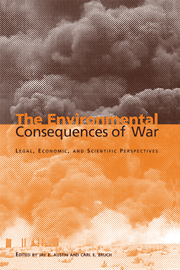Book contents
- Frontmatter
- Contents
- List of illustrations
- List of tables
- List of contributors
- Acknowledgements
- Foreword by Klaus Toepfer
- Introduction
- Part I General principles
- Part II The legal framework
- Part III Assessing the impacts – scientific methods and issues
- Part IV Valuing the impacts – economic methods and issues
- Introduction
- 19 Restoration-based approaches to compensation for natural resource damages: moving towards convergence in US and international law
- 20 Valuing public health damages arising from war
- 21 Valuing the health consequences of war
- Part V Prospects for the future
- Index
19 - Restoration-based approaches to compensation for natural resource damages: moving towards convergence in US and international law
Published online by Cambridge University Press: 04 August 2010
- Frontmatter
- Contents
- List of illustrations
- List of tables
- List of contributors
- Acknowledgements
- Foreword by Klaus Toepfer
- Introduction
- Part I General principles
- Part II The legal framework
- Part III Assessing the impacts – scientific methods and issues
- Part IV Valuing the impacts – economic methods and issues
- Introduction
- 19 Restoration-based approaches to compensation for natural resource damages: moving towards convergence in US and international law
- 20 Valuing public health damages arising from war
- 21 Valuing the health consequences of war
- Part V Prospects for the future
- Index
Summary
Introduction
In this chapter, I argue that the restoration-based approach to “full compensation” for social losses embodied in the 1996 US Oil Pollution Act regulations provides a valuable new model for other liability regimes designed to protect natural resources in international or national contexts. Though loss or damage by contamination or impairment of the environment is now generally recognized in international liability agreements, the definition of “environmental” or “ecological” damage is still evolving. In addition to the long-standing provision for response costs, the costs of “reinstatement” measures are a central element of compensation for environmental damage in the recent protocols. Some conventions define reinstatement extremely narrowly, limiting it to actual reinstatement of the injured resources; others allow for replacement of the “equivalent”, and some allow for monetary compensation when replacement of the equivalent is not possible.
The new measure of damages that has evolved in the United States also relies upon the cost of restoration measures and thereby provides a bridge to the international arena. However, the US measure differs from many international approaches in that it clearly establishes liability for the two elements of compensation required to make the public “whole”: not only (1) restoration or replacement of the injured resources; but also (2) compensation for interim losses during the time period from the injury until the injured resources or their replacements recover to their but-for-the-injury state.
This “full compensation” measure is consistent with a substantial body of law and economics literature that argues that, in order to provide adequate incentives for parties to take precautions to prevent harm to the environment, the responsible parties should bear the full social cost of accidents.
- Type
- Chapter
- Information
- The Environmental Consequences of WarLegal, Economic, and Scientific Perspectives, pp. 477 - 500Publisher: Cambridge University PressPrint publication year: 2000
- 1
- Cited by

